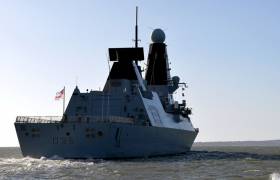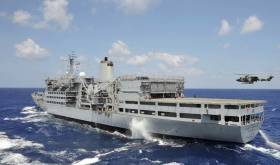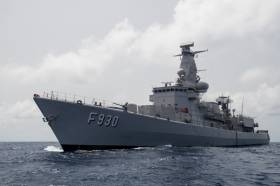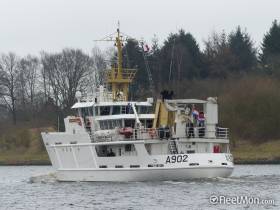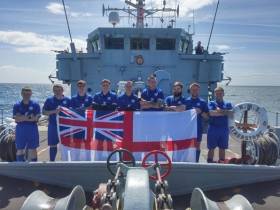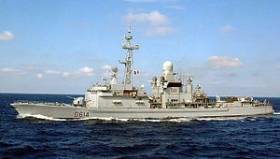Displaying items by tag: Naval Visits
Daring Dragon Destroyer Anchors During Volvo Cork Week
#DaringDragon - One of the UK’s most modern Royal Navy destroyers is also on a visit to Cork Harbour, having arrived yesterday afternoon, following that of a large auxiliary replenishment tanker-supply vessel, writes Jehan Ashmore.
The Type 45 ‘Daring’ Destroyer HMS Dragon (D35) displacing 8,000 tonnes is visiting as is the tanker RFA Fort Rosalie to coincide with Volvo Cork Week, hosted by the Royal Cork Yacht Club. In a new international services sailing competition, now part of Cork Week, Irish Defence Forces Team J19 yacht Joker 2 won the inaugural Beaufort Cup Fastnet Race out of 12 teams including those from the UK.
HMS Dragon which is on an anchorage call belongs to a class of six destroyers that are the backbone of the UK’s sea defence and on a worldwide basis. Primary roles are to hunt down on pirates, drug runners and submarines, in addition to defending the fleet from air attack and provide humanitarian aid after natural disasters.
RFA Fort Rosalie (A385), a Fort Class Solid Support Tanker of the Royal Auxiliary Fleet is berthed at Cobh’s deepwater berth, synonymous for cruise ships which this season sees 58 liners scheduled to call in 2016 bringing over 100,000 passengers and crew.
Likewise of RFA Fort Rosalie, the 152m long HMS Dragon is equipped with Phalanx systems, a key component in the arsenal of the navy. In addition is the principle anti-air missile, the Sea Viper which provides all-round defence. This is not just for the destroyer but for an entire naval task group and against all aerial threats some 70 miles away.
The Sea Viper can race towards its target at speeds in excess of Mach Four (over 3,000mph) using a series of tiny jets to manoeuvre, carrying out sharp turns at G forces no human could endure.
Note the ‘spinning egg’ atop the Type 45’s main mast which is a Sampson Radar that has a Combat Management System for long-range radar.
There is the Sylver missile-launching system on the destroyer's forecastle and Aster 15 and Aster 30 missiles with ranges up to 20 and 75 miles respectively.
Also mounted at the forecastle is the 4.5in main gun, found on all Royal Navy's destroyers and frigates, it is the most obvious provider of punch and firepower. The gun can fire up to two dozen high explosive shells, per minute, weighing more than 40kg (80lbs) at targets more than a dozen miles away.
The range can be extended to nearly 18 miles if special extended-range shells are used.
Large Royal Navy Supply Ship Sails in for Volvo Cork Week
#LargeUKvisitor - One of the largest UK naval vessels is at time of writing arriving into Cork Harbour this morning to coincide with Royal Cork Yacht Club’s Volvo Week, writes Jehan Ashmore.
The visit of RFA Fort Rosalie is also in the same year of the 70th anniversary of the foundation of the Irish Naval Service in 1946.
RFA Fort Rosalie (A385) is one of a pair of Fort Class Solid Support Tanker replenishment vessels of the Royal Fleet Auxiliary. She along with RFA Fort Austin and the overall RFA fleet also supply food, stores and ammunition to the Royal Navy fleet, whilst underway.
Also this morning, Naval Service CPV L.É. Orla, formerly HMS Swift of the Royal Navy Hong Kong Maritime Squadron met the 185m long auxiliary vessel off the entrance to Cork Harbour.
The RFA Fort Rosalie drawing 8m draft, had sailed from the French Naval Base at Brest, is to berth at Cobh’s deepwater quay.
Opposite of Cobh is Haulbowline Island where the Irish Naval Service Base is located and where the last major commemoration event, the 50th anniversary of the navy was held this month 20 years ago. On that occasion in July 1996 several foreign navies including the Royal Navy's HMS Manchester attended the 'Jubilee' event. The highlight I recall was the Fleet Review in Cork Harbour led by flagship L.É. Eithne.
The London registered 23,384 tonnes displacement RFA Fort Rosalie earlier this year at Portsmouth Naval Base assisted harbour tugs. This concerned an opportunity to put in some practice of towing large vessels ahead of the arrival next year of the 65,000 displacement tonnes HMS Queen Elizabeth.
One of the Aircraft Carrier Alliance contractors is Babcock International which to date has built the Naval Service OPV90 trio in which newbuild LE James Joyce is expected to be delivered next month.
As for the first of a pair of ‘QE’ new aircraft carriers under construction in Scotland, HMS Queen Elizabeth is to replace HMS Illustrious (see final Dublin call previously reported on Afloat.ie) Also see report on retirement as this year the UK's MOD announced that she is to be scrapped following the fate of her two ‘Invincible’ class sisters.
RFA Fort Rosalie is nearly 100m shorter and nearly three times lighter than the new carrier and sister HMS Prince of Wales. The Fort class auxiliary tanker-supplier ship is still considerably larger than any warship currently based in Portsmouth.
On the approaches to Portsmouth off the Nab Tower, some ten miles to the entrance to the port RFA Fort Rosalie was met by privately operated tugs from Serco, the Bountiful, Indulgent and Independent. The role of tugs had previously been part of RFA operations.
RFA Fort Rosalie built in 1978 and RFA Fort Austin each has a range of 10,000 miles at 20 knots, though the top speed can be 22 knots.
The Fort class have extensive aviation facilities, with 2 flight decks, one at the stern and one spot on top of the hanger. They have the ability to replenish at sea via 6 replenishment stations, three on each side as well as using helicopters for vertical replenishment (VERTREP).
Among defences, the pair have the Phalanx system, one of the deadly last lines of defence for the UK navy. Capable of engaging targets around one mile away, it is a radar-controlled Gatling gun which fires 20mm shells, that spews out 3,000 rounds a minute.
This is designed to engage incoming enemy aircraft and missiles if they penetrated a ship or task group's outer ring of defences such as Sea Viper or Sea Dart.
#FrigateSisters – A pair of former Dutch Navy frigates now part of the Belgium Navy docked within two hours of each other in Dublin Port yesterday for a weekend visit, writes Jehan Ashmore.
The first frigate to arrive BNS Louise-Marie (F931) docked at lunchtime with the attendance of port tugs when berthing at the North Wall Quay Extension. This quay is located next to the former East-Link Bridge which in May was officially unveiled as the Tom Clarke Bridge after a prominent figure of the 1916 Easter Rising.
The 3,328 tonnes BNS Louise-Marie frigate having sailed from Plymouth was joined by sister BNS Leopold I (F930), which had sailed from Bergen on the west coast of Norway. The latter vessel had moored alongside her counterpart, with both bows of the frigates facing seawards.
BNS Leopold I is a ‘Karel Doorman’-class frigate of the Naval Component of the Belgian Armed Forces, however originally she was the Royal Netherlands Navy’s HNLMS Karel Doorman (F827).
Likewise BNS Louise-Marie, was a former member of the Dutch fleet and as a sister named HNLMS Willem van der Zaan (F829) until they were purchased by the Belgiums in 2005. The leadship entered service for the Belgium Navy in 2007 and her sister was commissioned the following year.
Each of the 123m long frigates has a crew totalling 145 (15 officers, 70 non-commissioned officers and 60 sailors). Among the main weapons are eight Harpoon SSM and 16 x NATO Seasparrows and a single SGE-30 Goalkeeper. Also can be equipped is a Lynx or NH90 Helicopter.
During this month, BNS Leopold I had tested anti-ship missiles as part of a NATO flotilla that involved nations from Denmark, France, Netherlands, Norway, Spain and Turkey.
Last month during the May Bank Holiday a trio of Belgium Navy vessels also paid a courtesy call to the capital. On that occasion this involved an auxiliary command and logistical support ship, BNS Godetia.
At the beginning of next month, the annual Belgium Navy Days (1-2 July) will be held in Zeebrugge, where the naval base will be open to the public. Both of the frigates are to attend along with command and oceanographic survey ships.
#RoyalNavieS – The UK’s Royal Navy Faslane-based mine hunter HMS Ramsey has returned Scottish home waters this week, after a successful term of deployment as part of Standing Mine Counter Measures Group 1 (MCM1) NATO flotilla which Afloat adds visited the capital in April.
The Helensburgh Advertiser writes that crew seven from the MCM1, have most recently been operating the ‘Sandown’ Class vessel. The activity came after the visit to Dublin where the crew of HMS Ramsey hosted His Excellency the British Ambassador to Ireland, Dominick Chilcott.
The vessel trained alongside the Irish Navy when the NATO task group (incl. The Netherlands) sailed in the company of OPV90 LÉ James Joyce. She is second ‘Samuel-Beckett’ class off-shore patrol vessel and Afloat adds is a sister of LÉ William Butler Yeats that is to begin builder’s trials in early July. Also reported today is a new ‘fourth’ sister has been ordered by the Irish Government.
A Dutch Navy auxiliary ship, HNLMS Van Kinsbergen is next to call to Dublin Port with an arrival on Saturday. The small stout looking training ship of only 40m has an extra bridge fully equipped to enable trainees to work the 528 gross tonnage vessel.
#LeicesterBlue – A Royal Navy ‘Hunt’ class minehunter equipped with Sea-Fox mine-disposal team departed Dublin Port yesterday, the same day in which across the Irish Sea the City of Leicester also turned into a sea of blue, writes Jehan Ashmore.
The ‘Foxes’, the fans of Leicester City F.C. celebrated their championship of the Premier League title success as more than 240,000 people gathered in the city to watch the team’s open-top bus parade.
Crew members of HMS Atherstone (M38) which visited Dublin Port at the weekend until departing yesterday, had previously celebrated the historic and spectacular victory by beating Everton on 7 May. The club were 5,000-1 to win the title at the start of season.
It was during the game that sailors of HMS Atherstone a mine counter measures vessel (MCMV) while on a northbound transit through UK waters, cheer and celebrate Leicester City Football Club’s triumph.
In the latter half of 2015, Leicester City stepped in and sent out a new strip for Crew 4 following a call to assist with their old torn kit. The football team nicknamed the 'The Fighting Foxes' on board the 685 tonnes displacement vessel were then on a deployment in the Gulf.
HMS Atherstone, whose affiliated town is just 20 miles from Leicester, have found since inheriting the playing kit, that they have enjoyed a long spell of good luck including their 7000nm transit home from Bahrain last year arriving home just before Christmas.
NATO Naval Visitors Included Submarine With “X” Tail
#NATOsub - Belgian Navy vessels are visiting Dublin Port over this May bank holiday weekend. They follow calls from two other members of NATO, France and Netherlands whose non-nuclear powered submarine HNLMS Walrus features an unusual stern design as explained below, writes Jehan Ashmore.
Beginning firstly with the Belgian trio, they are BNS Godetia, an auxiliary command and logistical support ship, BNS Lobelia a ‘Tripartite’ class minehunter and BNS Pollux a patrol vessel. Unlike the Dutch and French navies, they are berthed much closer to the city centre along Sir John Rogersons Quay.
It was on Wednesday that the Royal Netherlands Navy submarine HNLMS Walrus (2,650 tonnes when submerged) made a lunchtime departure from the port’s Alexandra Basin.
What makes the ‘Walrus’ class (equipped with almost 40 torpedoes), more unusual to other submarines, is instead of a cross-shaped assembly of stern diving planes and rudders, they mount four combined rudders and diving planes in an "X" tail configuration (see photo above).
The 68m long submarine draws a draft of 7.5m and was built by the Rotterdamsche Droogdok Maatschappij (Rotterdam Dry Dock Co). In 1979 a serious fire delayed the construction of the submarine and the commissioning into service finally took place in 1992.
Also departing on Wednesday was the French Navy auxiliary tanker, Var, that berthed opposite the submarine on the south quays.
This left the second French caller, the destroyer, Cassard to remain in Alexandra Basin until a farewell from the capital on the following day.
#ThirdNavyVisitor – It’s been a busy week so far in Dublin Port in terms of visiting European navies, as the Belgians are the latest to call to the capital from where French and Dutch vessels in recent days have departed, writes Jehan Ashmore.
Of the Belgium Navy, three vessels this morning berthed at Sir John Rogersons Quay. They are BNS Godetia, an auxiliary command and logistical support ship, BNS Lobelia a ‘Tripartite’ class minehunter and BNS Pollux a patrol vessel. A sister of Lobelia, the BNS Primula formed one of the six NATO flotilla vessels that called to Dublin at the beginning of this month.
The Belgium trio have been honing naval exercise skills off the Welsh coast before heading off Wicklow Head and their arrival to Dublin Port around dawn. Their Irish visit takes place over the May Bank Holiday weekend.
Of the most recent departures, that was the French destroyer Cassard from Alexandra Basin yesterday, and on the previous day fleetmate Var, an auxiliary tanker.
Also to depart on Wednesday was Dutch submarine, HNLMS Walrus. The 68m long ‘Walrus’ class submarine departed Alexandra Basin with the assistence of tug sisters, Beaufort and Shackleton.
#1916sub2016 – A Dutch attack-reconnaissance submarine docked in Dublin Port today, in the same week of the 100th anniversary of Sir Roger Casement’s landing in Co. Kerry from a German U- boat, writes Jehan Ashmore.
The 2,650 displacement tonnes (submerged) Royal Netherlands Navy ‘Walrus’ class submarine HNLMS Walrus was met by Dublin Port tug Beaufort off Scotsmans Bay, Dun Laoghaire Harbour. At mid-afternoon the submarine proceeded to Dublin Port.
HNLMS Walrus is the leadship of a quartet and the class are regarded as among the most sophisticated non-nuclear submarines in the world. They are the only submarines in the navy which have responsibility for patrolling the Dutch territories in the Caribbean where there are two naval bases in Curaçao and one on Aruba.
Submarine off howth head #submarine #howth #irishsea pic.twitter.com/jwPXOF3PLH
— Daniel (@dapr86) April 24, 2016
The submarine has been in service since 1990. A speed of 13 knots (24 km/h) is achieved when surfaced and submerged is reported to be 20 knots (37 km/h).
At almost 68m long the HNLMS Walrus is some 12m shorter of the Irish Naval Service OPV80 class L.É. Niamh (not the L.É. Aoife*) as reported on the Irish Times story on the occasion at Banna Strand where President Higgins addressed the ceremony of Casement's capture. This was the biggest State centenary commemoration of the 1916 Easter Rising to take place outside of Dublin.
The ceremony including an Air Corps flyover, was the first major event to coincide with the chronological centenary of the Rising that began this day 100 years ago.
In attendance at the Kerry event were relatives of Casement and ambassadors from the UK and Germany. A wreath was also laid in front of the anchor of a German gun smuggling ship the Aud, in the guise as a Norwegian cargoship.
Earlier this month a flotilla of naval vessels comprising some members that make up the North Atlantic Treaty Organisation (NATO) paid a courtesy call to Dublin Port. The navies involved were from the UK, Germany, Belgium, Netherlands and Norway.
*L.É. Aoife was decomissioned in 2015. The Irish Government donated the OPV to the Armed Forces (AFM) of Malta where also last year as the 'P62' the patrol vessel made a delivery voyage to Valetta.
French Navy with 400 Crew Visit Dublin on Extended Shore Leave
#ExtendedVisit – Almost 400 visiting crew members from a pair of French Navy vessels that docked in Dublin Port as reported yesterday, will remain berthed in the capital on extended shore leave up to next Thursday, writes Jehan Ashmore.
The naval vessels are a destroyer and an auxiliary replenishment tanker and will not be open to public unlike the NATO flotilla that called to the capital earlier this month.
Normally such visits are confined over a weekend, but on this occasion the call to the capital involves an extended leave during the centenary of the 1916 Easter Rising that begins tomorrow.
The F70 AA or ‘Cassard’ Class leadship Cassard (D 614) one of two sisters, are guided-missile destroyers despite the French Navy that designate them as frigates. The 5,000 deadweight replacement tonnes destroyer has a crew of 230 and was joined yesterday lunchtime by ‘Durance’ class replenishment tanker Var (A 608) with a crew of 150.
The destroyer docked within Alexandra Basin located in the centre of the port while downriver at Ocean Pier is where the 18,000 tonnes displacement at full load tanker berthed.
Cassard was launched in 1985 and three years later was commissioned into service. The 139m long frigate has a top speed of 30 knots. Main armament consists of Mistral and Exocet missiles. A hanger is where Panther type helicopters provide additional capabilities for the Cassard class.
Replenishment auxiliary tanker Var was launched in Brest in 1981 and two years later entered service. The 157m long tanker can achieve a more modest 19 knots and has a range of defence equipment among them a pair of 20 mm Oerlikon guns.
Likewise of the destroyer, Var can handle a Panther helicopter along with a variety of other such aircraft, among the examples are the Dauphin, Cougar, Gazelle and Puma.
Another French Navy Double Act Bound for Dublin Bay
#FrenchDouble - Following earlier this month’s NATO flotilla to Dublin Port, a pair of French Naval vessels are to make an appearance albeit they will not be open to the public, writes Jehan Ashmore.
The F70 AA class frigate Cassard (D 614) along with an auxiliary replenishment tanker Var (A 608) are to arrive in Dublin Bay tomorrow. The former is due in Dublin Port in the morning while the later takes a lunchtime slot.
Unlike the NATO visitors which berthed near the East-Link bridge, the French visitors will be away from the public gaze. The frigate will be tucked away in the adjacent Alexandra Basin. As for the ‘Durance’ class tanker, this vessel will be berthed downriver at Ocean Pier.
At the same time of the NATO flotilla, Afloat reported that of the visit to Dun Laoghaire Harbour of another French Navy pair of the Leopard class cadet trainee vessels.



























